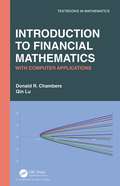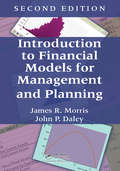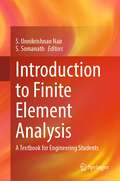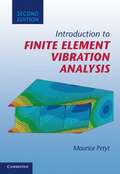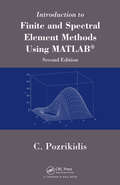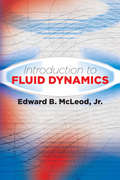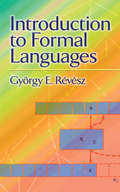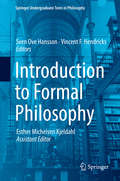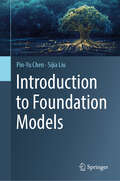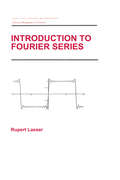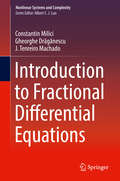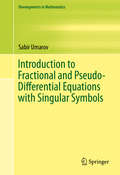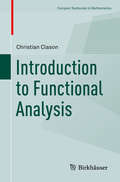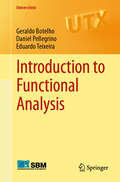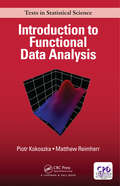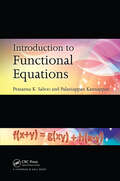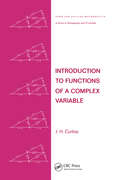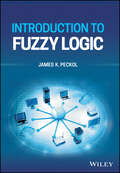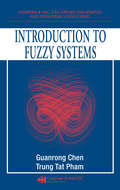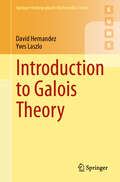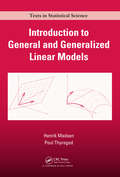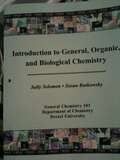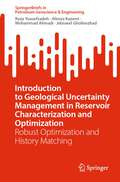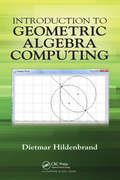- Table View
- List View
Introduction to Financial Mathematics (Advances in Applied Mathematics)
by Kevin J. HastingsIntroduction to Financial Mathematics is ideal for an introductory undergraduate course. Unlike most textbooks aimed at more advanced courses, the text motivates students through a discussion of personal finances and portfolio management. The author then goes on to cover valuation of financial derivatives in discrete time, using all of closed form,
Introduction to Financial Mathematics: With Computer Applications (Textbooks in Mathematics)
by Donald R. Chambers Qin LuThis book’s primary objective is to educate aspiring finance professionals about mathematics and computation in the context of financial derivatives. The authors offer a balance of traditional coverage and technology to fill the void between highly mathematical books and broad finance books. The focus of this book is twofold: To partner mathematics with corresponding intuition rather than diving so deeply into the mathematics that the material is inaccessible to many readers. To build reader intuition, understanding and confidence through three types of computer applications that help the reader understand the mathematics of the models. Unlike many books on financial derivatives requiring stochastic calculus, this book presents the fundamental theories based on only undergraduate probability knowledge. A key feature of this book is its focus on applying models in three programming languages –R, Mathematica and EXCEL. Each of the three approaches offers unique advantages. The computer applications are carefully introduced and require little prior programming background. The financial derivative models that are included in this book are virtually identical to those covered in the top financial professional certificate programs in finance. The overlap of financial models between these programs and this book is broad and deep.
Introduction to Financial Models for Management and Planning
by James R. Morris John P. DaleyA properly structured financial model can provide decision makers with a powerful planning tool that helps them identify the consequences of their decisions before they are put into practice. Introduction to Financial Models for Management and Planning, Second Edition enables professionals and students to learn how to develop and use computer-based models for financial planning. This volume provides critical tools for the financial toolbox, then shows how to use them tools to build successful models.
Introduction to Finite Element Analysis: A Textbook for Engineering Students
by S. Unnikrishnan Nair S. SomanathThis textbook covers the basic concepts and applications of finite element analysis. It is specifically aimed at introducing this advanced topic to undergraduate-level engineering students and practicing engineers in a lucid manner. It also introduces a structural and heat transfer analysis software FEASTSMT which has wide applications in civil, mechanical, nuclear and automobile engineering domains. This software has been developed by generations of scientists and engineers of Vikram Sarabhai Space Centre and Indian Space Research Organisation. Supported with many illustrative examples, the textbook covers the classical methods of estimating solutions of mathematical models. The book is written in an easy-to-understand manner. This textbook also contains numeral exercise problems to aid self-learning of the students. The solutions to these problems are demonstrated using finite element software. Furthermore, the textbook contains several tutorials and associated online resources on usage of the FEASTSMT software. Given the contents, this textbook is highly useful for the undergraduate students of various disciplines of engineering. It is also a good reference book for the practicing engineers.
Introduction to Finite Element Vibration Analysis
by Maurice PetytThis is an introduction to the mathematical basis of finite element analysis as applied to vibrating systems. Finite element analysis is a technique that is very important in modeling the response of structures to dynamic loads. Although this book assumes no previous knowledge of finite element methods, those who do have knowledge will still find the book to be useful. It can be utilised by aeronautical, civil, mechanical, and structural engineers as well as naval architects. This second edition includes information on the many developments that have taken place over the last twenty years. Existing chapters have been expanded where necessary, and three new chapters have been included that discuss the vibration of shells and multi-layered elements and provide an introduction to the hierarchical finite element method.
Introduction to Finite and Spectral Element Methods Using MATLAB
by Constantine PozrikidisIncorporating new topics and original material, Introduction to Finite and Spectral Element Methods Using MATLAB, Second Edition enables readers to quickly understand the theoretical foundation and practical implementation of the finite element method and its companion spectral element method. Readers gain hands-on computational experience by using
Introduction to Fluid Dynamics
by Edward B. Mcleod Jr.Concise, unified, and logical, this introduction to the study of the basic principles of fluid dynamics emphasizes the statement of problems in mathematical language. In addition to its value as a reference for professional engineers, this volume is suitable for advanced undergraduates and graduate students of mathematics and engineering. Some familiarity with the algebra of vector fields is assumed, and a useful appendix provides a succinct review of vector algebra.An introductory chapter covers fundamental notions from the continuum hypothesis to steady-state flow. Succeeding chapters explore conservation of mass, forces acting on a fluid in equilibrium, dynamic equations of motion, irrotational motion, integration of Euler's equation in special cases, and flows representable by harmonic functions. Additional topics include two dimensional flows, rectilinear vortices, general vortex motion, flows with a free boundary, and compressible fluids.
Introduction to Formal Languages (Dover Books on Mathematics)
by György E. RévészThis highly technical introduction to formal languages in computer science covers all areas of mainstream formal language theory, including such topics as operations on languages, context-sensitive languages, automata, decidability, syntax analysis, derivation languages, and more. Geared toward advanced undergraduates and graduate students, the treatment examines mathematical topics related to mathematical logic, set theory, and linguistics. All subjects are integral to the theory of computation.Numerous worked examples appear throughout the book, and end-of-chapter exercises enable readers to apply theory and methods to real-life problems. Elegant mathematical proofs are provided for almost all theorems.
Introduction to Formal Philosophy (Springer Undergraduate Texts In Philosophy Ser.)
by Vincent F. Hendricks Sven Ove Hansson Esther Michelsen KjeldahlThis Undergraduate Textbook introduces key methods and examines the major areas of philosophy in which formal methods play pivotal roles. Coverage begins with a thorough introduction to formalization and to the advantages and pitfalls of formal methods in philosophy. The ensuing chapters show how to use formal methods in a wide range of areas. Throughout, the contributors clarify the relationships and interdependencies between formal and informal notions and constructions. Their main focus is to show how formal treatments of philosophical problems may help us understand them better. Formal methods can be used to solve problems but also to express new philosophical problems that would never have seen the light of day without the expressive power of the formal apparatus. Formal philosophy merges work in different areas of philosophy as well as logic, mathematics, computer science, linguistics, physics, psychology, biology, economics, political theory, and sociology. This title offers an accessible introduction to this new interdisciplinary research area to a wide academic audience.
Introduction to Foundation Models
by Pin-Yu Chen Sijia LiuThis book offers an extensive exploration of foundation models, guiding readers through the essential concepts and advanced topics that define this rapidly evolving research area. Designed for those seeking to deepen their understanding and contribute to the development of safer and more trustworthy AI technologies, the book is divided into three parts providing the fundamentals, advanced topics in foundation modes, and safety and trust in foundation models: Part I introduces the core principles of foundation models and generative AI, presents the technical background of neural networks, delves into the learning and generalization of transformers, and finishes with the intricacies of transformers and in-context learning. Part II introduces automated visual prompting techniques, prompting LLMs with privacy, memory-efficient fine-tuning methods, and shows how LLMs can be reprogrammed for time-series machine learning tasks. It explores how LLMs can be reused for speech tasks, how synthetic datasets can be used to benchmark foundation models, and elucidates machine unlearning for foundation models. Part III provides a comprehensive evaluation of the trustworthiness of LLMs, introduces jailbreak attacks and defenses for LLMs, presents safety risks when find-tuning LLMs, introduces watermarking techniques for LLMs, presents robust detection of AI-generated text, elucidates backdoor risks in diffusion models, and presents red-teaming methods for diffusion models. Mathematical notations are clearly defined and explained throughout, making this book an invaluable resource for both newcomers and seasoned researchers in the field.
Introduction to Fourier Series (Chapman And Hall/crc Pure And Applied Mathematics Ser. #199)
by Rupert LasserThis work addresses all of the major topics in Fourier series, emphasizing the concept of approximate identities and presenting applications, particularly in time series analysis. It stresses throughout the idea of homogenous Banach spaces and provides recent results. Techniques from functional analysis and measure theory are utilized.;College and university bookstores may order five or more copies at a special student price, available on request from Marcel Dekker, Inc.
Introduction to Fractional Differential Equations (Nonlinear Systems And Complexity Ser. #25)
by Constantin Milici Gheorghe Drăgănescu J. Tenreiro MachadoThis book introduces a series of problems and methods insufficiently discussed in the field of Fractional Calculus – a major, emerging tool relevant to all areas of scientific inquiry. The authors present examples based on symbolic computation, written in Maple and Mathematica, and address both mathematical and computational areas in the context of mathematical modeling and the generalization of classical integer-order methods. Distinct from most books, the present volume fills the gap between mathematics and computer fields, and the transition from integer- to fractional-order methods.
Introduction to Fractional and Pseudo-Differential Equations with Singular Symbols
by Sabir UmarovThe book systematically presents the theories of pseudo-differential operators with symbols singular in dual variables, fractional order derivatives, distributed and variable order fractional derivatives, random walk approximants, and applications of these theories to various initial and multi-point boundary value problems for pseudo-differential equations. Fractional Fokker-Planck-Kolmogorov equations associated with a large class of stochastic processes are presented. A complex version of the theory of pseudo-differential operators with meromorphic symbols based on the recently introduced complex Fourier transform is developed and applied for initial and boundary value problems for systems of complex differential and pseudo-differential equations.
Introduction to Functional Analysis (Compact Textbooks in Mathematics)
by Christian ClasonFunctional analysis has become one of the essential foundations of modern applied mathematics in the last decades, from the theory and numerical solution of differential equations, from optimization and probability theory to medical imaging and mathematical image processing. This textbook offers a compact introduction to the theory and is designed to be used during one semester, fitting exactly 26 lectures of 90 minutes each. It ranges from the topological fundamentals recalled from basic lectures on real analysis to spectral theory in Hilbert spaces. Special attention is given to the central results on dual spaces and weak convergence.
Introduction to Functional Analysis (Universitext)
by Geraldo Botelho Daniel Pellegrino Eduardo TeixeiraThis textbook offers an accessible introduction to Functional Analysis, providing a solid foundation for students new to the field. It is designed to support learners with no prior background in the subject and serves as an effective guide for introductory courses, suitable for students in mathematics and other STEM disciplines. The book provides a comprehensive introduction to the essential topics of Functional Analysis across the first seven chapters, with a particular emphasis on normed vector spaces, Banach spaces, and continuous linear operators. It examines the parallels and distinctions between Functional Analysis and Linear Algebra, highlighting the crucial role of continuity in infinite-dimensional spaces and its implications for complex mathematical problems. Later chapters broaden the scope, including advanced topics such as topological vector spaces, techniques in Nonlinear Analysis, and key theorems in theory of Banach spaces. Exercises throughout the book reinforce understanding and allow readers to test their grasp of the material. Designed for students in mathematics and other STEM disciplines, as well as researchers seeking a thorough introduction to Functional Analysis, this book takes a clear and accessible approach. Prerequisites include a strong foundation in analysis in the real line, linear algebra, and basic topology, with helpful references provided for additional consultation.
Introduction to Functional Data Analysis (Chapman & Hall/CRC Texts in Statistical Science)
by Piotr Kokoszka Matthew Reimherr<p>Introduction to Functional Data Analysis provides a concise textbook introduction to the field. It explains how to analyze functional data, both at exploratory and inferential levels. It also provides a systematic and accessible exposition of the methodology and the required mathematical framework. <p>The book can be used as textbook for a semester-long course on FDA for advanced undergraduate or MS statistics majors, as well as for MS and PhD students in other disciplines, including applied mathematics, environmental science, public health, medical research, geophysical sciences and economics. It can also be used for self-study and as a reference for researchers in those fields who wish to acquire solid understanding of FDA methodology and practical guidance for its implementation. Each chapter contains plentiful examples of relevant R code and theoretical and data analytic problems. <p>The material of the book can be roughly divided into four parts of approximately equal length: 1) basic concepts and techniques of FDA, 2) functional regression models, 3) sparse and dependent functional data, and 4) introduction to the Hilbert space framework of FDA. The book assumes advanced undergraduate background in calculus, linear algebra, distributional probability theory, foundations of statistical inference, and some familiarity with R programming. Other required statistics background is provided in scalar settings before the related functional concepts are developed. Most chapters end with references to more advanced research for those who wish to gain a more in-depth understanding of a specific topic.</p>
Introduction to Functional Equations
by Prasanna K. Sahoo Palaniappan KannappanIntroduction to Functional Equations grew out of a set of class notes from an introductory graduate level course at the University of Louisville. This introductory text communicates an elementary exposition of valued functional equations where the unknown functions take on real or complex values. In order to make the presentation as manageable as p
Introduction to Functions of a Complex Variable (Chapman And Hall/crc Pure And Applied Mathematics Ser. #44)
by J. H. CurtissThis book includes information on elementary general topology, the Cauchy Integral Theorem and concepts of homology and homotopy in their application to the Cauchy theory. It is intended for an introductory course in complex analysis at the first-year graduate and advanced undergraduate level.
Introduction to Fuzzy Logic
by James K. PeckolINTRODUCTION TO FUZZY LOGIC Learn more about the history, foundations, and applications of fuzzy logic in this comprehensive resource by an academic leader Introduction to Fuzzy Logic delivers a high-level but accessible introduction to the rapidly growing and evolving field of fuzzy logic and its applications. Distinguished engineer, academic, and author James K. Peckol covers a wide variety of practical topics, including the differences between crisp and fuzzy logic, the people and professionals who find fuzzy logic useful, and the advantages of using fuzzy logic. While the book assumes a solid foundation in embedded systems, including basic logic design, and C/C++ programming, it is written in a practical and easy-to-read style that engages the reader and assists in learning and retention. The author includes introductions of threshold and perceptron logic to further enhance the applicability of the material contained within. After introducing readers to the topic with a brief description of the history and development of the field, Introduction to Fuzzy Logic goes on to discuss a wide variety of foundational and advanced topics, like: A review of Boolean algebra, including logic minimization with algebraic means and Karnaugh maps A discussion of crisp sets, including classic set membership, set theory and operations, and basic classical crisp set properties A discussion of fuzzy sets, including the foundations of fuzzy set logic, set membership functions, and fuzzy set properties An analysis of fuzzy inference and approximate reasoning, along with the concepts of containment and entailment and relations between fuzzy subsets Perfect for mid-level and upper-level undergraduate and graduate students in electrical, mechanical, and computer engineering courses, Introduction to Fuzzy Logic covers topics included in many artificial intelligence, computational intelligence, and soft computing courses. Math students and professionals in a wide variety of fields will also significantly benefit from the material covered in this book.
Introduction to Fuzzy Systems (Chapman & Hall/CRC Applied Mathematics & Nonlinear Science)
by Guanrong Chen Trung Tat PhamIntroduction to Fuzzy Systems provides students with a self-contained introduction that requires no preliminary knowledge of fuzzy mathematics and fuzzy control systems theory. Simplified and readily accessible, it encourages both classroom and self-directed learners to build a solid foundation in fuzzy systems. To keep pace with and further advance the rapidly developing field of applied control technologies, this book provides systematic training in the analytic theory and rigorous design of fuzzy systems. Almost entirely self-contained, it establishes a brief, yet sufficient foundation for designing and analyzing fuzzy intelligent and control systems. It clearly explains fuzzy sets, fuzzy logic, fuzzy inference, approximate reasoning, fuzzy rule base, basic fuzzy PID control systems, and more. This outstanding text includes teaching examples as well as problem exercises, and it can easily be used as a classroom text or tutorial for self-study that will prepare readers for further work in the field.
Introduction to Galois Theory (Springer Undergraduate Mathematics Series)
by David Hernandez Yves LaszloThis textbook provides an undergraduate introduction to Galois theory and its most notable applications. Galois theory was born in the 19th century to study polynomial equations. Both powerful and elegant, this theory was at the origin of a substantial part of modern algebra and has since undergone considerable development. It remains an extremely active research subject and has found numerous applications beyond pure mathematics. In this book, the authors introduce Galois theory from a contemporary point of view. In particular, modern methods such as reduction modulo prime numbers and finite fields are introduced and put to use. Beyond the usual applications of ruler and compass constructions and solvability by radicals, the book also includes topics such as the transcendence of e and π, the inverse Galois problem, and infinite Galois theory. Based on courses of the authors at the École Polytechnique, the book is aimed at students with a standard undergraduate background in (mostly linear) algebra. It includes a collection of exam questions in the form of review exercises, with detailed solutions.
Introduction to General and Generalized Linear Models (Chapman & Hall/CRC Texts in Statistical Science)
by Henrik Madsen Poul ThyregodBridging the gap between theory and practice for modern statistical model building, Introduction to General and Generalized Linear Models presents likelihood-based techniques for statistical modelling using various types of data. Implementations using R are provided throughout the text, although other software packages are also discussed. Numerous
Introduction to General, Organic and Biological Chemistry
by Charles Solomon Susan Sally Rutkowsky BortizIntroduction to General, Organic, and Biological Chemistry
Introduction to Geological Uncertainty Management in Reservoir Characterization and Optimization: Robust Optimization and History Matching (SpringerBriefs in Petroleum Geoscience & Engineering)
by Jebraeel Gholinezhad Reza Yousefzadeh Alireza Kazemi Mohammad AhmadiThis book explores methods for managing uncertainty in reservoir characterization and optimization. It covers the fundamentals, challenges, and solutions to tackle the challenges made by geological uncertainty. The first chapter discusses types and sources of uncertainty and the challenges in different phases of reservoir management, along with general methods to manage it. The second chapter focuses on geological uncertainty, explaining its impact on field development and methods to handle it using prior information, seismic and petrophysical data, and geological parametrization. The third chapter deals with reducing geological uncertainty through history matching and the various methods used, including closed-loop management, ensemble assimilation, and stochastic optimization. The fourth chapter presents dimensionality reduction methods to tackle high-dimensional geological realizations. The fifth chapter covers field development optimization using robust optimization, including solutions for its challenges such as high computational cost and risk attitudes. The final chapter introduces different types of proxy models in history matching and robust optimization, discussing their pros and cons, and applications. The book will be of interest to researchers and professors, geologists and professionals in oil and gas production and exploration.
Introduction to Geometric Algebra Computing: Computing with Circles and Lines (Computer Vision Series)
by Dietmar HildenbrandFrom the Foreword: "Dietmar Hildenbrand's new book, Introduction to Geometric Algebra Computing, in my view, fills an important gap in Clifford's geometric algebra literature…I can only congratulate the author for the daring simplicity of his novel educational approach taken in this book, consequently combined with hands on computer based exploration. Without noticing, the active reader will thus educate himself in elementary geometric algebra algorithm development, geometrically intuitive, highly comprehensible, and fully optimized." --Eckhard Hitzer, International Christian University, Tokyo, Japan Geometric Algebra is a very powerful mathematical system for an easy and intuitive treatment of geometry, but the community working with it is still very small. The main goal of this book is to close this gap with an introduction to Geometric Algebra from an engineering/computing perspective. This book is intended to give a rapid introduction to computing with Geometric Algebra and its power for geometric modeling. From the geometric objects point of view, it focuses on the most basic ones, namely points, lines and circles. This algebra is called Compass Ruler Algebra, since it is comparable to working with a compass and ruler. The book explores how to compute with these geometric objects, and their geometric operations and transformations, in a very intuitive way. The book follows a top-down approach, and while it focuses on 2D, it is also easily expandable to 3D computations. Algebra in engineering applications such as computer graphics, computer vision and robotics are also covered.

